
Apatura iris, the purple emperor, is a Palearctic butterfly of the family Nymphalidae.

The map is a butterfly of the family Nymphalidae.

Apatura ilia, the lesser purple emperor, is a species of butterfly native to most of Europe and east across the Palearctic. It is named for its similarity to the purple emperor butterfly.

Erebia epistygne, the spring ringlet, is a species of butterfly in the family Nymphalidae. It is found in France and Spain. Its natural habitat is temperate grassland.
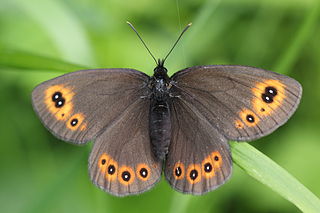
Erebia medusa, the woodland ringlet, is a member of the subfamily Satyrinae of the family Nymphalidae.
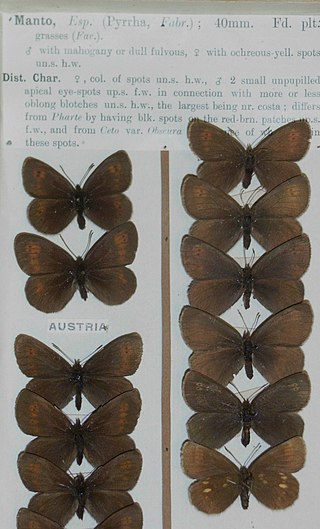
The yellow-spotted ringlet is a member of the subfamily Satyrinae of the family Nymphalidae. It is associated with (sub)alpine meadows at 900–2,500 m above sea level. It is found in the Alps, the Pyrenees, the Cantabrian Mountains, the Massif Central, the Vosges Mountains, the Carpathian Mountains and the mountains of Herzegovina.
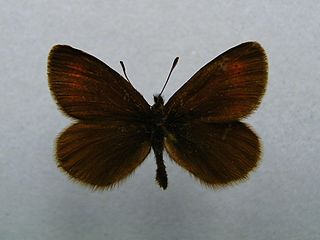
The Eriphyle ringlet is a member of the subfamily Satyrinae of family Nymphalidae. It is a high mountain butterfly found in the Alps.Wheeler (1903) gives a short description
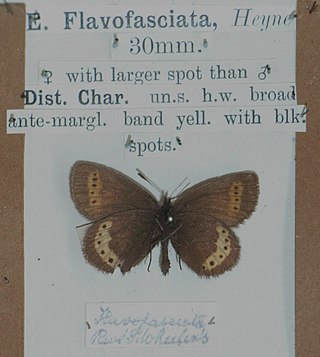
The yellow-banded ringlet is a member of the subfamily Satyrinae of the family Nymphalidae. It is a high mountain butterfly found in a small area of the Alps in Switzerland and Italy.

The Styrian ringlet is a member of the subfamily Satyrinae of the family Nymphalidae. It is a mountain butterfly found in the Austrian and Italian Alps, Croatia and Slovenia.

The black ringlet is a member of the subfamily Satyrinae of the family Nymphalidae. It is a high-altitude butterfly found in Albania, former Yugoslavia, Bulgaria, Greece, and Romania.
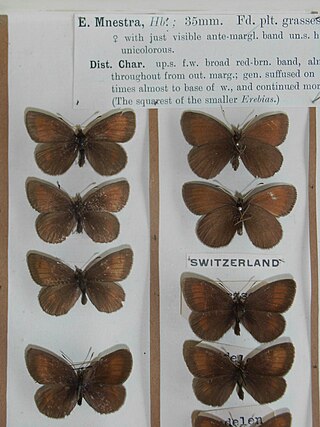
Mnestra's ringlet is a member of the subfamily Satyrinae of the family Nymphalidae. It is a mountain butterfly found in the Alps of Austria, France, Italy and Switzerland. The Mnestra's ringlet is named for Mnestra, a daughter of Erysichthon, king of Thessaly in Greek mythology.

Setina irrorella, the dew moth, is a moth of the family Erebidae. The species was first described by Carl Linnaeus in his 1758 10th edition of Systema Naturae. It is found in the Palearctic from Ireland, then through Europe and east to northern and central Asia to the Pacific Ocean. It is missing in the high north and parts of the Mediterranean region. It is found also in the limestone Alps up to 2,000 meters above sea level.

Conistra rubiginea, the dotted chestnut, is a moth of the family Noctuidae. The species was first described by Michael Denis and Ignaz Schiffermüller in 1775. It is distributed in Europe and, according to William Warren, Armenia and Asia Minor.

Boloria frigga, the Frigga fritillary, is a butterfly of the family Nymphalidae with a circumboreal distribution. It occurs in bogs and tundra in Northern Europe to the north of 60° N, very locally in more southern locations, as well as in the Urals, Siberia, Northern Mongolia, the Russian Far East, western parts of the United States and Canada.

Chazara briseis, the hermit, is a butterfly species belonging to the family Nymphalidae. It can be found in North Africa, southern Europe, Asia Minor, the Caucasus, Kazakhstan, Central Asia through Afghanistan, and north-western China and Tuva. It is found on steppe and in other dry grassy places between 500 and 2,500 meters.

Boloria pales, the shepherd's fritillary, is a butterfly of the family Nymphalidae. It is found from the Cantabrian Mountains and the Pyrenees through the Alps and Apennine Mountains east to the Balkan, Carpathian Mountains, the Caucasus and central Asia up to western China.

Erebia pandrose, the dewy ringlet, is a member of the subfamily Satyrinae of the family Nymphalidae. It is found from the Arctic areas of northern Europe, the Pyrenees, Alps, the Apennine Mountains, the Carpathian Mountains, Kola Peninsula and Kanin Peninsula, part of the Ural and the Altai and Sayan Mountains up to Mongolia.

Erebia melampus, the lesser mountain ringlet, is a member of the subfamily Satyrinae of the family Nymphalidae.

Melitaea arduinna, or Freyer's fritillary, is a butterfly of the family Nymphalidae. It is found from south-eastern Europe across Asia Minor to central Asia and the Altai. The habitat consists of steppe-clad slopes.
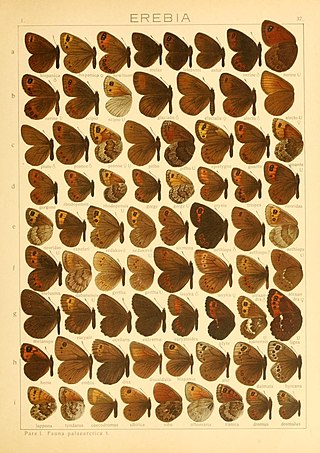
Erebia dabanensis is a small butterfly found in the East Palearctic that belongs to the browns family.




















